Abstract
The influence of exhaustive exercise on the capacity of liver and muscle of rats to oxidize fatty acids was investigated in vitro. The rate of oxidation of fatty acids by liver preparations was significantly elevated as a result of exhaustion. Concurrently, the concentrations of beta-hydroxybutyrate were elevated in the plasma of the exhausted rats, suggesting that oxidation of fatty acids was also elevated in vivo. These findings are analogous to the findings of increased oxidation of fatty acids that results from training. In muscle, oxidation of palmitate, palmitoylcarnitine and beta-hydroxybutyrate by homogenates and isolated mitochondria was depressed with exercise. Despite the decrease in the oxidative capacity of the muscle preparations, the activities of several enzymes of beta-oxidation were either increased or unchanged as a result of exercise, suggesting that the depression in fatty acid oxidation may not be related to alterations in the process of beta-oxidation. Further studies showed that oxidation of [2-(14)C]pyruvate by muscle was depressed, whereas oxidation of [1-(14)C]pyruvate was not changed as a result of exercise. These results suggest that the decrease in fatty acid oxidation may be related to aberrations in the oxidation of acetyl-CoA. The changes in fatty acid oxidation that were observed, which are at variance with what is reported to occur with training, may have resulted from increased fragility of muscle mitochondria as a result of exercise. This increased fragility may render the mitochondria more susceptible to experimental manipulations in vitro and a subsequent loss of normal function.
Full text
PDF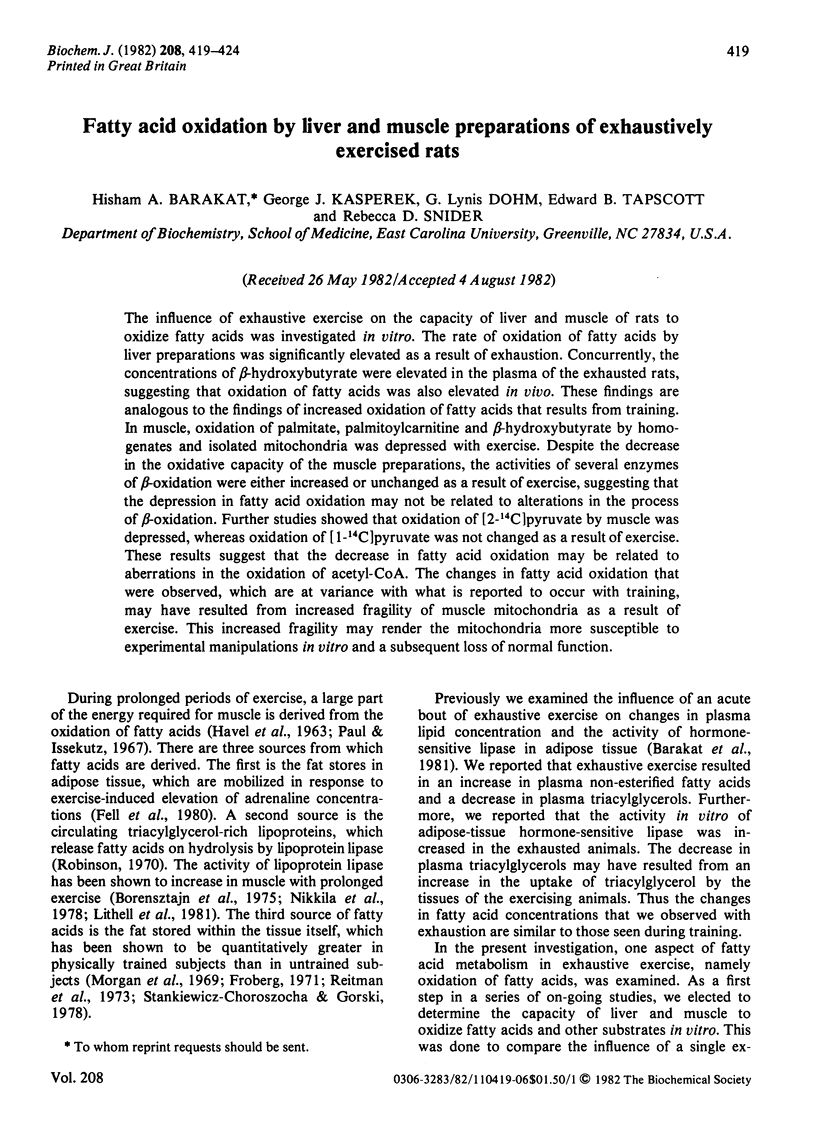
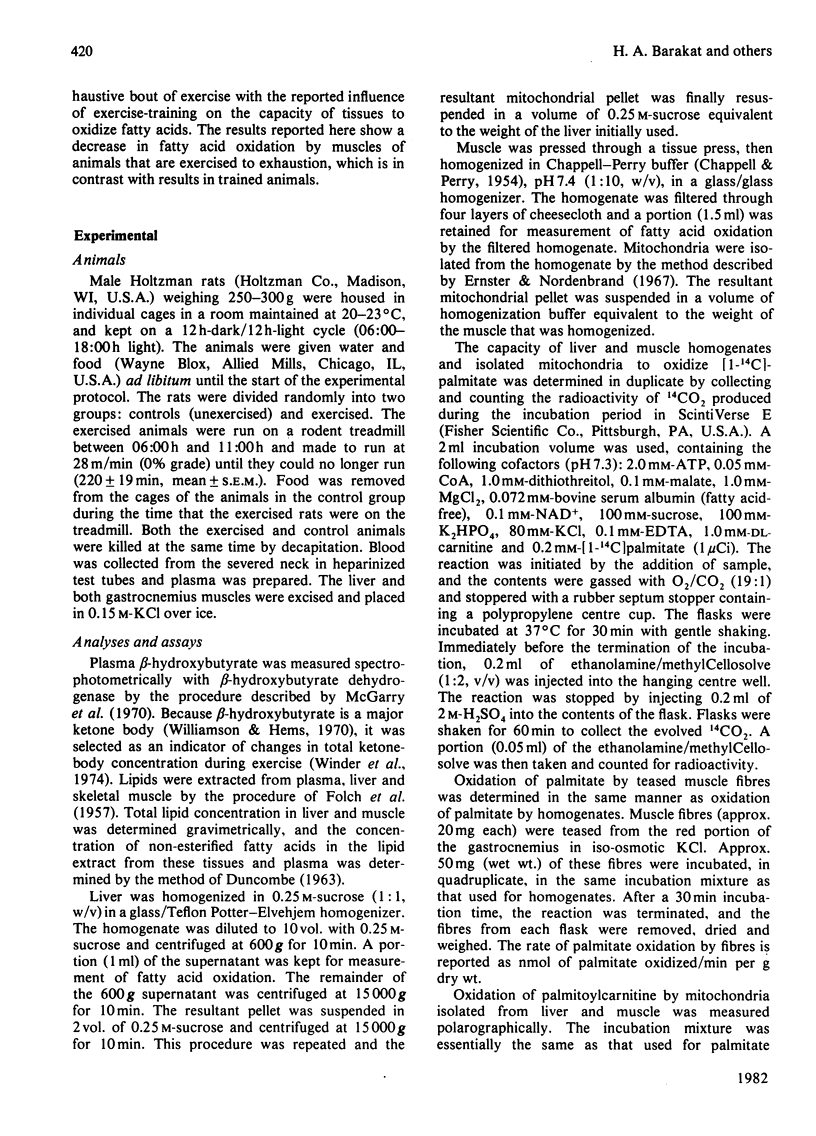
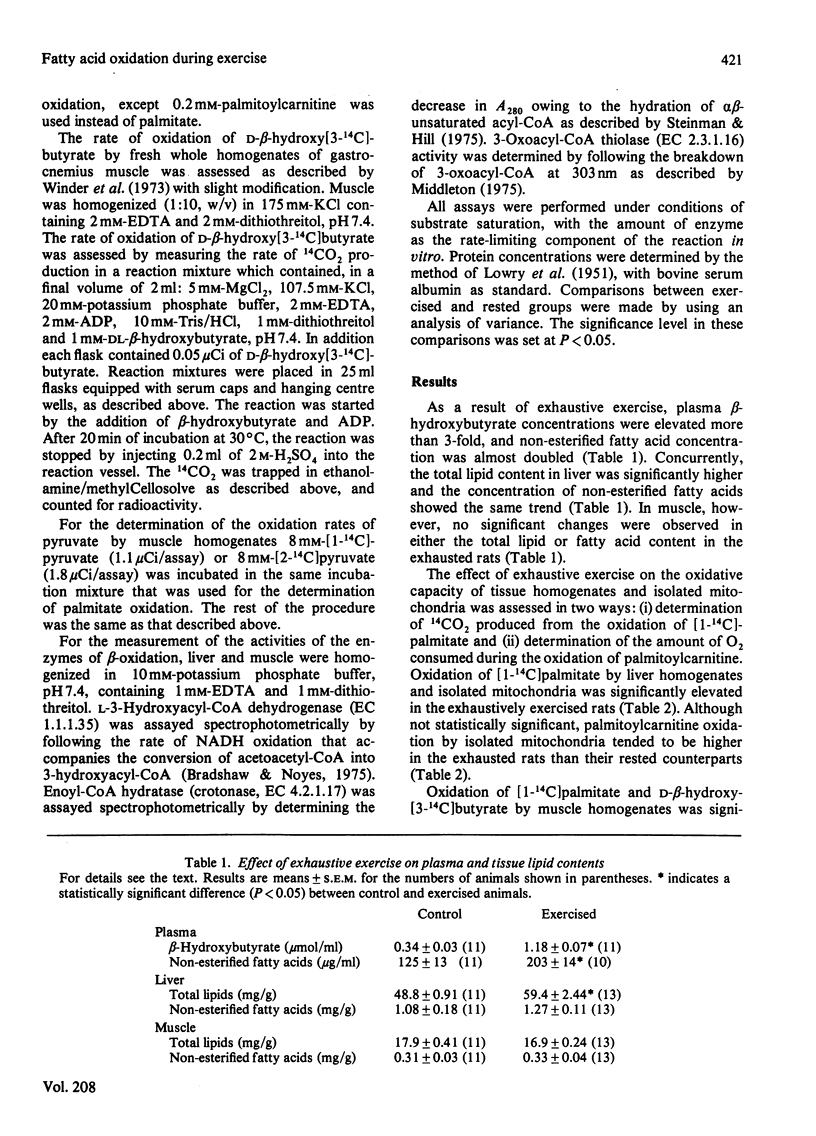
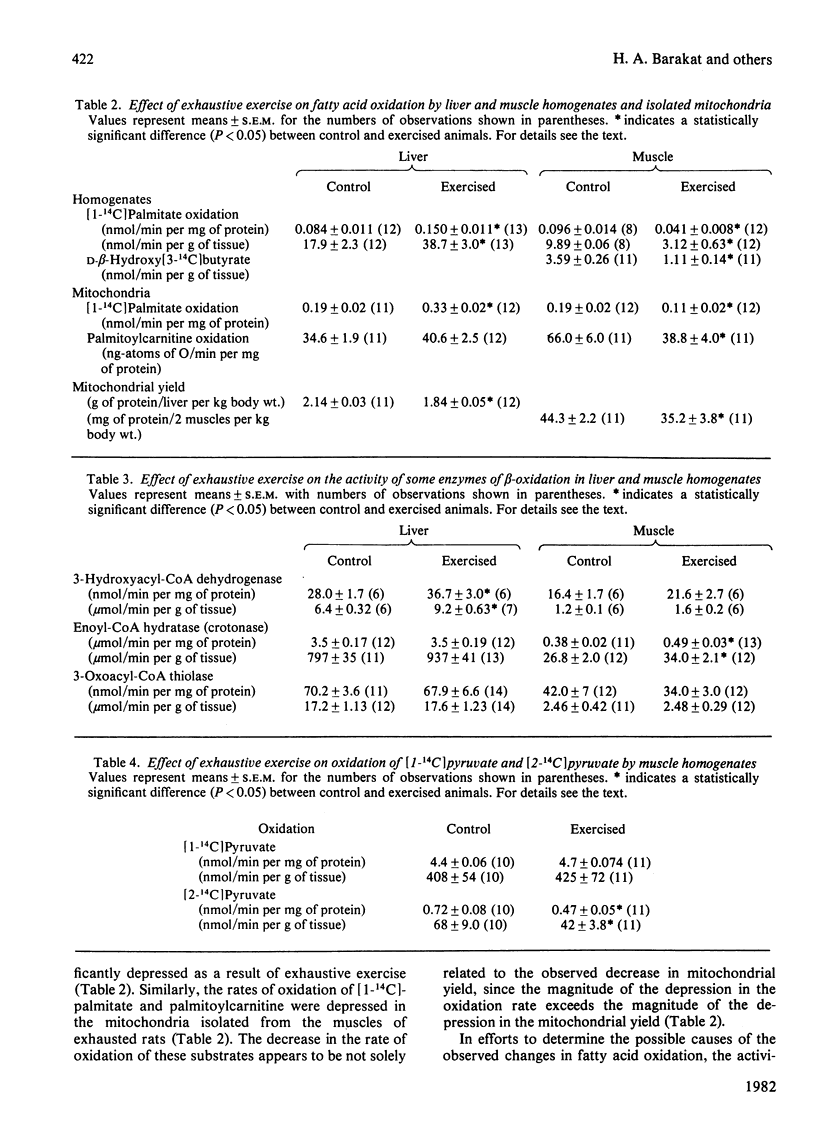
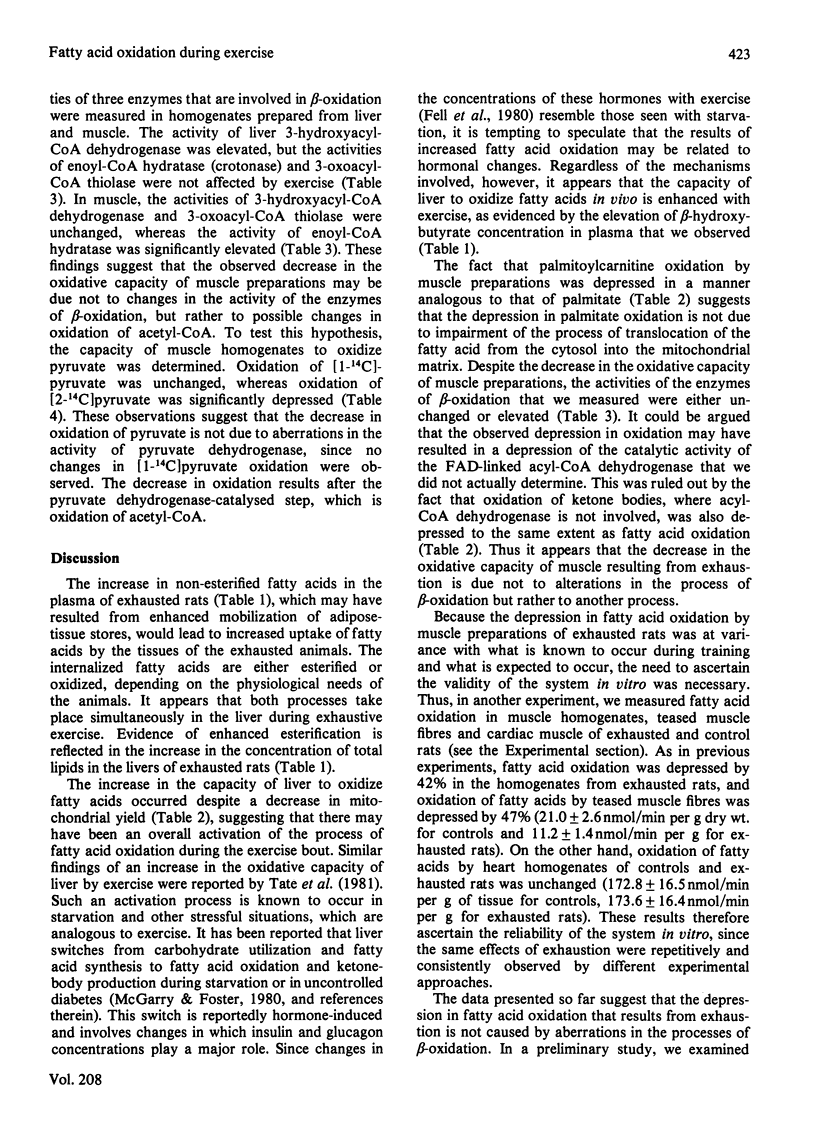
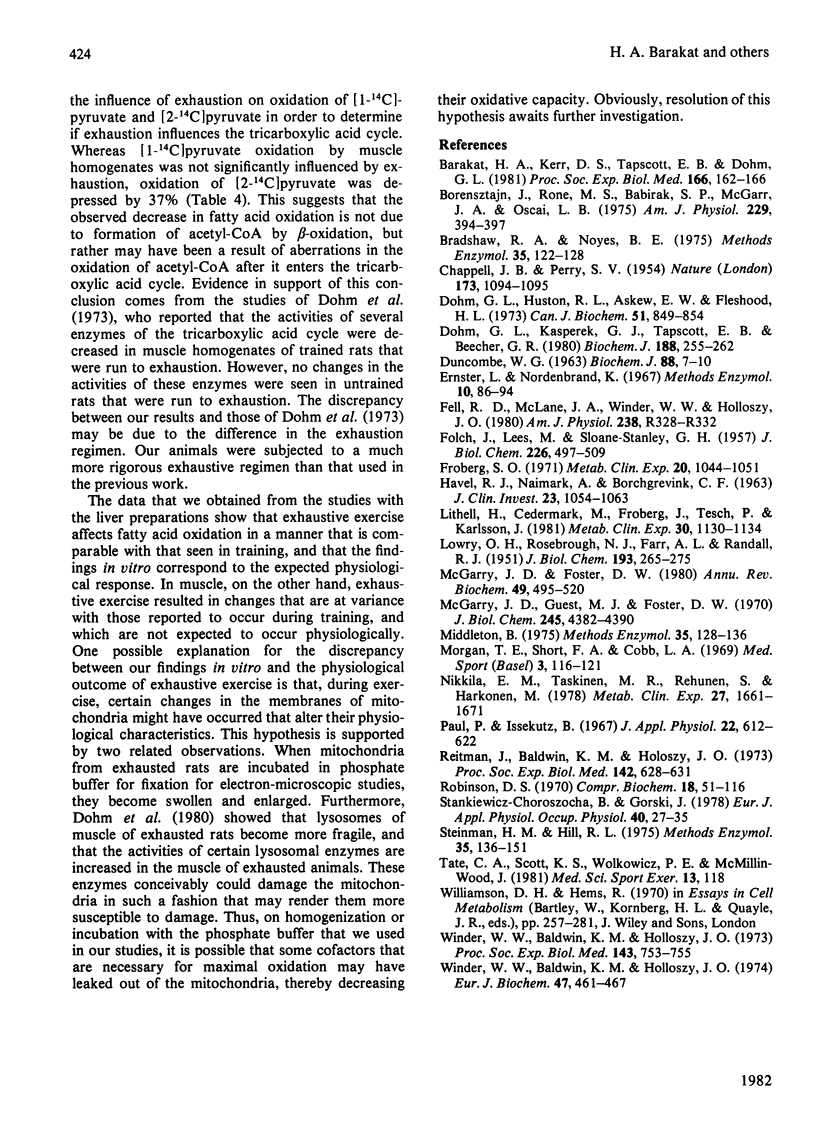
Selected References
These references are in PubMed. This may not be the complete list of references from this article.
- Barakat H. A., Kerr D. S., Tapscott E. B., Dohm G. L. Changes in plasma lipids and lipolytic activity during recovery from exercise of untrained rats. Proc Soc Exp Biol Med. 1981 Feb;166(2):162–166. doi: 10.3181/00379727-166-41040. [DOI] [PubMed] [Google Scholar]
- Borensztajn J., Rone M. S., Babirak S. P., McGarr J. A., Oscai L. B. Effect of exercise on lipoprotein lipase activity in rat heart and skeletal muscle. Am J Physiol. 1975 Aug;229(2):394–397. doi: 10.1152/ajplegacy.1975.229.2.394. [DOI] [PubMed] [Google Scholar]
- Bradshaw R. A., Noyes B. E. L-3-hydroxyacyl coenzyme A dehydrogenase from pig heart muscle. EC 1.1.1.35 L-3-hydroxyacyl-CoA: NAD oxidoreductase. Methods Enzymol. 1975;35:122–128. doi: 10.1016/0076-6879(75)35147-1. [DOI] [PubMed] [Google Scholar]
- CHAPPELL J. B., PERRY S. V. Biochemical and osmotic properties of skeletal muscle mitochondria. Nature. 1954 Jun 5;173(4414):1094–1095. doi: 10.1038/1731094a0. [DOI] [PubMed] [Google Scholar]
- Dohm G. L., Huston R. L., Askew E. W., Fleshood H. L. Effects of exercise, training, and diet on muscle citric acid cycle enzyme activity. Can J Biochem. 1973 Jun;51(6):849–854. doi: 10.1139/o73-105. [DOI] [PubMed] [Google Scholar]
- Dohm G. L., Kasperek G. J., Tapscott E. B., Beecher G. R. Effect of exercise on synthesis and degradation of muscle protein. Biochem J. 1980 Apr 15;188(1):255–262. doi: 10.1042/bj1880255. [DOI] [PMC free article] [PubMed] [Google Scholar]
- Duncombe W. G. The colorimetric micro-determination of long-chain fatty acids. Biochem J. 1963 Jul;88(1):7–10. doi: 10.1042/bj0880007. [DOI] [PMC free article] [PubMed] [Google Scholar]
- FOLCH J., LEES M., SLOANE STANLEY G. H. A simple method for the isolation and purification of total lipides from animal tissues. J Biol Chem. 1957 May;226(1):497–509. [PubMed] [Google Scholar]
- Fell R. D., McLane J. A., Winder W. W., Holloszy J. O. Preferential resynthesis of muscle glycogen in fasting rats after exhausting exercise. Am J Physiol. 1980 May;238(5):R328–R332. doi: 10.1152/ajpregu.1980.238.5.R328. [DOI] [PubMed] [Google Scholar]
- Fröberg S. O. Effects of training and of acute exercise in trained rats. Metabolism. 1971 Nov;20(11):1044–1051. doi: 10.1016/0026-0495(71)90028-x. [DOI] [PubMed] [Google Scholar]
- HAVEL R. J., NAIMARK A., BORCHGREVINK C. F. Turnover rate and oxidation of free fatty acids of blood plasma in man during exercise: studies during continuous infusion of palmitate-1-C14. J Clin Invest. 1963 Jul;42:1054–1063. doi: 10.1172/JCI104791. [DOI] [PMC free article] [PubMed] [Google Scholar]
- Lithell H., Cedermark M., Fröberg J., Tesch P., Karlsson J. Increase of lipoprotein-lipase activity in skeletal muscle during heavy exercise. Relation to epinephrine excretion. Metabolism. 1981 Nov;30(11):1130–1134. doi: 10.1016/0026-0495(81)90059-7. [DOI] [PubMed] [Google Scholar]
- McGarry J. D., Guest M. J., Foster D. W. Ketone body metabolism in the ketosis of starvation and alloxan diabetes. J Biol Chem. 1970 Sep 10;245(17):4382–4390. [PubMed] [Google Scholar]
- Middleton B. 3-Ketoacyl-CoA thiolases of mammalian tissues. Methods Enzymol. 1975;35:128–136. doi: 10.1016/0076-6879(75)35148-3. [DOI] [PubMed] [Google Scholar]
- Nikkilä E. A., Taskinen M. R., Rehunen S., Härkönen M. Lipoprotein lipase activity in adipose tissue and skeletal muscle of runners: relation to serum lipoproteins. Metabolism. 1978 Nov;27(11):1661–1667. doi: 10.1016/0026-0495(78)90288-3. [DOI] [PubMed] [Google Scholar]
- Paul P., Issekutz B., Jr Role of extramuscular energy sources in the metabolism of the exercising dog. J Appl Physiol. 1967 Apr;22(4):615–622. doi: 10.1152/jappl.1967.22.4.615. [DOI] [PubMed] [Google Scholar]
- Reitman J., Baldwin K. M., Holloszy J. O. Intramuscular triglyceride utilization by red, white, and intermediate skeletal muscle and heart during exhausting exercise. Proc Soc Exp Biol Med. 1973 Feb;142(2):628–631. doi: 10.3181/00379727-142-37081. [DOI] [PubMed] [Google Scholar]
- Stankiewicz-Choroszucha B., Górski J. Effect of decreased availability of substrates on intramuscular triglyceride utilization during exercise. Eur J Appl Physiol Occup Physiol. 1978 Dec 15;40(1):27–35. doi: 10.1007/BF00420986. [DOI] [PubMed] [Google Scholar]
- Steinman H. M., Hill R. L. Bovine liver crotonase (enoyl coenzyme A hydratase). EC 4.2.1.17 L-3-hydroxyacyl-CoA hydrolyase. Methods Enzymol. 1975;35:136–151. doi: 10.1016/0076-6879(75)35149-5. [DOI] [PubMed] [Google Scholar]
- Winder W. W., Baldwin K. M., Holloszy J. O. Enzymes involved in ketone utilization in different types of muscle: adaptation to exercise. Eur J Biochem. 1974 Sep 16;47(3):461–467. doi: 10.1111/j.1432-1033.1974.tb03713.x. [DOI] [PubMed] [Google Scholar]
- Winder W. W., Baldwin K. M., Holloszy J. O. Exercise-induced adaptive increase in rate of oxidation of beta-hydroxybutyrate by skeletal muscle. Proc Soc Exp Biol Med. 1973 Jul;143(3):753–755. doi: 10.3181/00379727-143-37406. [DOI] [PubMed] [Google Scholar]


